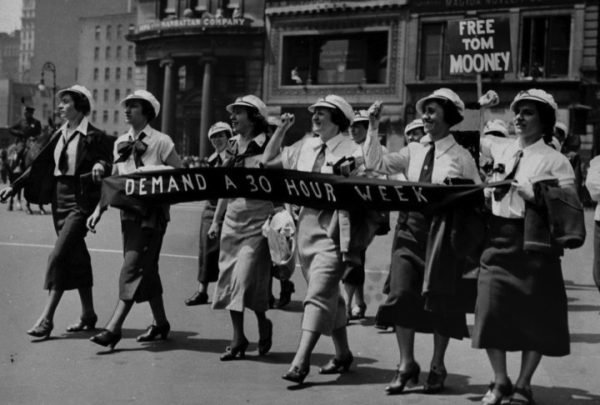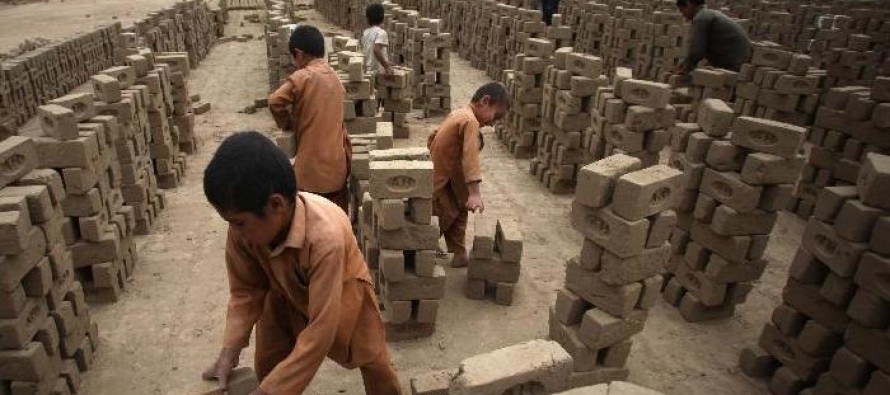 اول ماه می به عنوان روز کارگر به این لحاظ بوده است که در چهارم ماه می سال ۱۸۸۶، و در چهارمین روز اعتصاب و تجمع کارگران آمریکایی در شهر شیکاگو، پلیس به روی آنان آتش گشود که شماری کشته، عدهای مجروح و بعداً چهارتن نیز اعدام شدند. کارگران بخاطر کاهش ساعت کار روزانه از (ده ساعت به هشت ساعت) دست به اعتصاب زدند. قرار بود که اول ماه مه ۱۸۸۶ در آمریکا (ایالات متحده)، کاهش ساعات کار به هشت ساعت در روز، به اجرا درآید که چنین نشد و در نتیجه،
اول ماه می به عنوان روز کارگر به این لحاظ بوده است که در چهارم ماه می سال ۱۸۸۶، و در چهارمین روز اعتصاب و تجمع کارگران آمریکایی در شهر شیکاگو، پلیس به روی آنان آتش گشود که شماری کشته، عدهای مجروح و بعداً چهارتن نیز اعدام شدند. کارگران بخاطر کاهش ساعت کار روزانه از (ده ساعت به هشت ساعت) دست به اعتصاب زدند. قرار بود که اول ماه مه ۱۸۸۶ در آمریکا (ایالات متحده)، کاهش ساعات کار به هشت ساعت در روز، به اجرا درآید که چنین نشد و در نتیجه،

کارگران در گوشه وکنار این کشور دست به تظاهرات زدند و در یکهزار ودوصد کارخانه و کارگاه، اعتصاب صورت گرفت. شمار کارگران معترض شهر شیکاگو بیش از سایر شهرها و حدود ۹۰ هزار تن بود. در چهارمین روز تظاهرات شیکاگو، کارگران اعتصابی و هوادارانشان در «میدان بیده = Haymarket» جمع شده و از اینجا به حرکت درآمده بودند. سخنرانان آنان بر یک گادی بزرگ سوار بودند و شعار میدادند. پس از طی مسافتی، پلیس اطراف این گادی را گرفت و خواست که تظاهرکنندگان متفرق شوند که ناگهان انفجاری صورت گرفت، یک مأمور پلیس کشته شد و چند کارگر و پلیس نیز مجروح شدند. این حادثه سبب شد که پلیس دست به کارشوند وبطرف تظاهرکنندگان فیر نمایند. یس با اعمال خشونت موفق شد جمعیت را پراکنده سازد. در پی این حادثه، هشت تن به رهبری تظاهرات دستگیر شدند که پنج نفر از آنان کارگر مهاجر آلمانی و یکی هم آلمانی تبعه آمریکا بود. دادگاه یکی از این دستگیر شدگان را به ۱۵ سال حبس محکوم کرد و بقیه محکوم به اعدام شدند که فرماندار ایالت مجازات دو تن از آنان را به حبس ابد تخفیف داد. یکی از محکومان به اعدام، پیش از اجرای حکم خودکشی کرد و چهار نفر دیگر به دار آویخته شدند.با رسیدن اخبار مربوط به این تظاهرات، کشتار و اعدام به سایر کشورها، در گوشه و کنار جهان مراسم یاد بود برگزار و هر سال هم تکرار شد که به تدریج اول ماه مه، روز جهانی کارگر عنوان گرفت. چون اعدامشدگان شیکاگو عمدتاً آلمانی بودند، در سال ۱۹۳۳ حزب نازی آلمان روز اول ماه مه را روز ملی و تعطیل عمومی اعلام کرد.
حقوق طفل از نگاه حقوق بشر در افغانستان چطور تامین میشود ؟.
تاریخ این روز خونین را از منایع امریکائی نیز مطالعه بدارید .
The Bloody Story of How May Day Became a Holiday for Workers
Lily Rothman
Updated: 8:16 AM ET | Originally published: May 01, 2015
Celebrations on May 1 have long had two, seemingly contradictory meanings. On one hand, May Day is known for maypoles, flowers and welcoming the spring. On the other hand, it’s a day of worker solidarity and protest; though the U.S. observes its official Labor Day in September, many countries will celebrate Labor Day on Monday.
How did that happen?
Like so many historical twists, by complete accident. As TIME explained in 1929, “To old-fashioned people, May Day means flowers, grass, picnics, children, clean frocks. To up-and-doing Socialists and Communists it means speechmaking, parading, bombs, brickbats, conscientious violence. This connotation dates back to May Day, 1886, when some 200,000 U. S. workmen engineered a nationwide strike for an eight-hour day.”
The May 1, 1886, labor action wasn’t just any strike—it was part of what became known as the Haymarket affair. On May 1 of that year, Chicago (along with other cities) was the site of a major union demonstration in support of the eight-hour workday. The Chicago protests were meant to be part of several days of action. On May 3, a strike at the McCormick Reaper plant in the city turned violent; the next day, a peaceful meeting at Haymarket Square became even more so. Here’s how TIME summed it up in 1938:
A few minutes after ten o’clock on the night of May 4, 1886, a storm began to blow up in Chicago. As the first drops of rain fell, a crowd in Haymarket Square, in the packing house district, began to break up. At eight o’clock there had been 3,000 persons on hand, listening to anarchists denounce the brutality of the police and demand the eight-hour day, but by ten there were only a few hundred. The mayor, who had waited around in expectation of trouble, went home, and went to bed. The last speaker was finishing his talk when a delegation of 180 policemen marched from the station a block away to break up what remained of the meeting. They stopped a short distance from the speaker’s wagon. As a captain ordered the meeting to disperse, and the speaker cried out that it was a peaceable gathering, a bomb exploded in the police ranks. It wounded 67 policemen, of whom seven died. The police opened fire, killing several men and wounding 200, and the Haymarket Tragedy became a part of U. S. history.
In 1889, the International Socialist Conference declared that, in commemoration of the Haymarket affair, May 1 would be an international holiday for labor, now known in many places as International Workers’ Day.
In the U.S., that holiday came in for particular contempt during the anti-communist fervor of the early Cold War. In July of 1958, President Eisenhower signed a resolution named May 1 “Loyalty Day” in an attempt to avoid any hint of solidarity with the “workers of the world” on May Day. The resolution declared that it would be “a special day for the reaffirmation of loyalty to the United States of America and for the recognition of the heritage of American freedom.”
Women of Steel: LIFE With Female Factory Workers in World War II
Women laborers clear tracks of spilled materials, Gary, Ind. 1943.
Women wearing gas masks clean a blast furnace top at a Gary, Ind. steel mill, 1943.
Women employees at Tubular Alloy Steel Corp. in Gary, Ind. predominate at pep meeting, 1943.
Bernice Daunora, 31, a member of a steel mill’s “top gang” who must wear a “one-hour, lightweight breathing apparatus” as protection against gas escaping from blast furnaces, Gary, Ind., 1943.
Theresa Arana, 21, takes down temperature recordings at draw furnaces, Gary, Ind., 1943.
Stamping machine in rail mill at Gary is operated by Mrs. Florence Romanowski (right). She mechanically brands identifications into red-hot rails. Her husband is in Army
Gary, Ind. war effort, 1943
Women welders, Gary, Ind., 1943.
Gary, Ind. war effort, 1943
Gary, Ind. war effort, 1943
Gary, Ind. war effort, 1943
Gary, Ind. war effort, 1943
Gary, Ind. war effort, 1943
Gary, Ind. war effort, 1943
Gary, Ind. war effort, 1943
Gary, Ind. war effort, 1943
Gary, Ind. war effort, 1943
Gary, Ind. war effort, 1943
Gary, Ind. war effort, 1943
Gary, Ind. war effort, 1943
Gary, Ind. war effort, 1943
Gary, Ind. war effort, 1943
Gary, Ind. war effort, 1943
LIFE magazine cover August 9, 1943
